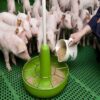The production of goods is a fundamental aspect of economic activity, encompassing the processes and systems through which raw materials are transformed into finished products. This transformation involves various stages, including extraction, manufacturing, assembly, and distribution, each requiring different resources, labor, and technologies.
The efficiency and effectiveness of these production processes are critical in determining the overall productivity and competitiveness of an economy. Historically, the production of goods has evolved significantly. In early human societies, production was primarily manual, relying on basic tools and human labor.
With the advent of the Industrial Revolution in the 18th and 19th centuries, production processes underwent a dramatic shift. The introduction of machinery and the development of factory systems enabled mass production, leading to significant increases in output and efficiency.
This period marked the beginning of mechanized production, where machines began to take over tasks previously performed by human hands, thereby increasing productivity and reducing costs. Technology plays a crucial role in the production of goods, influencing every stage of the production process.
One of the most significant technological advancements in production has been automation. Automation involves the use of control systems, such as computers or robots, to operate machinery and processes, reducing the need for human intervention.
This not only enhances efficiency and precision but also improves safety by reducing the risk of human error. For example, in the automotive industry, robots are used extensively in assembly lines to perform tasks such as welding, painting, and assembly with high precision and speed.
Another critical technological advancement is the development of information and communication technology (ICT). ICT has revolutionized production processes by facilitating better coordination, monitoring, and control of production activities. E
nterprise Resource Planning (ERP) systems, for instance, integrate various business processes, including production, inventory management, and procurement, into a single cohesive system. This integration allows for real-time monitoring and decision-making, leading to improved efficiency and responsiveness to market demands.
Additionally, the Internet of Things (IoT) has further enhanced production by enabling the interconnection of devices and machinery, allowing for real-time data collection and analysis. This connectivity facilitates predictive maintenance, reducing downtime and improving the overall reliability of production systems.
Advancements in materials science have also significantly impacted the production of goods. The development of new materials, such as advanced polymers, composites, and nanomaterials, has led to the creation of products with superior properties, such as increased strength, durability, and lightweight characteristics.
These materials not only improve the performance of products but also enable more efficient production processes. For example, the use of lightweight materials in the aerospace industry has led to the development of more fuel-efficient aircraft, reducing operational costs and environmental impact.
Moreover, additive manufacturing, commonly known as 3D printing, has emerged as a transformative technology in the production of goods. Unlike traditional subtractive manufacturing methods, which involve cutting away material to create a product, additive manufacturing builds products layer by layer using digital designs.
This approach allows for greater design flexibility, reduced material waste, and the ability to produce complex geometries that would be challenging or impossible with conventional methods. 3D printing is increasingly being used in industries such as healthcare, aerospace, and automotive for the production of customized and high-precision components.
One way technology can improve the production of goods is through the implementation of advanced quality control systems powered by artificial intelligence. AI-driven quality control systems can automatically inspect and detect defects in products at various stages of the manufacturing process, ensuring high standards of quality are maintained.
This reduces the likelihood of defective products reaching the market, minimizes waste, and saves costs associated with product recalls and returns. The integration of artificial intelligence (AI) and machine learning into production processes is another significant technological development.
AI and machine learning algorithms can analyze vast amounts of data to optimize production processes, predict demand, and enhance quality control. For example, in the semiconductor industry, AI is used to analyze data from production lines to identify defects and optimize manufacturing processes, leading to higher yields and reduced production costs.
Sustainability is another critical aspect where technology is playing a transformative role in the production of goods. With growing concerns about environmental impact and resource depletion, there is a significant push towards sustainable production practices.
Technologies such as renewable energy, recycling, and waste management systems are being integrated into production processes to minimize environmental impact. For instance, many manufacturing facilities are adopting solar and wind energy to power their operations, reducing reliance on fossil fuels and lowering carbon emissions.
Additionally, advancements in recycling technologies are enabling the efficient recovery and reuse of materials, reducing waste, and conserving natural resources. The concept of Industry 4.0, also known as the fourth industrial revolution, encapsulates many of these technological advancements.
Industry 4.0 represents the integration of digital technologies, such as AI, IoT, and big data analytics, into production processes, creating smart factories that are highly automated and interconnected. These smart factories can operate with minimal human intervention, optimize production in real time, and adapt to changing market conditions quickly. The result is a more efficient, flexible, and responsive production system that can meet the demands of a rapidly changing global market.
Read Also: One Way Technology Can Help Improve the Distribution of Goods
The Current Challenges in the Production of Goods

The production of goods is a critical aspect of any economy, driving growth, employment, and innovation. However, this sector faces numerous challenges that impact its efficiency, sustainability, and overall effectiveness. These challenges are multifaceted, involving economic, technological, environmental, and social dimensions.
Addressing these issues is essential for ensuring that the production of goods can meet the demands of a growing global population while maintaining economic viability and environmental sustainability. One of the primary challenges in the production of goods is the increasing complexity of global supply chains.
The production of goods often involves sourcing raw materials and components from various parts of the world, which can lead to logistical difficulties and increased vulnerability to disruptions. Events such as natural disasters, geopolitical tensions, and pandemics can severely impact supply chains, leading to delays, increased costs, and shortages of essential materials.
For instance, the COVID-19 pandemic highlighted the fragility of global supply chains, as lockdowns and travel restrictions disrupted the flow of goods, causing significant delays in production and delivery. Another significant challenge in the production of goods is the rising cost of raw materials and energy.
The extraction and processing of raw materials are becoming increasingly expensive due to factors such as resource depletion, environmental regulations, and geopolitical conflicts. Additionally, energy costs are a major concern, as the production of goods is energy-intensive.
Fluctuations in energy prices, driven by factors such as geopolitical instability and changes in energy policy, can significantly impact production costs. Manufacturers are under constant pressure to find ways to reduce energy consumption and enhance energy efficiency to remain competitive.
Labor shortages and skills gaps also pose significant challenges in the production of goods. As industries become more technologically advanced, there is a growing demand for skilled workers who can operate and maintain sophisticated machinery and systems.
However, many regions face a shortage of workers with the necessary technical skills, leading to difficulties in filling critical positions. This skills gap can slow down production processes, reduce efficiency, and increase operational costs.
Moreover, the aging workforce in many developed countries exacerbates this problem, as experienced workers retire and there are insufficient numbers of younger workers to replace them. Environmental sustainability is another major challenge in the production of goods.
The production processes often have significant environmental impacts, including greenhouse gas emissions, water pollution, and waste generation. As awareness of climate change and environmental degradation grows, there is increasing pressure on manufacturers to adopt more sustainable practices.
This includes reducing carbon footprints, minimizing waste, and using resources more efficiently. However, transitioning to sustainable production methods can be costly and complex, requiring significant investments in new technologies and processes.
Technological advancements, while offering numerous benefits, also present challenges in the production of goods. The rapid pace of technological change means that manufacturers must continuously adapt and upgrade their equipment and processes to stay competitive.
This can be particularly challenging for small and medium-sized enterprises (SMEs), which may lack the financial resources and technical expertise to implement advanced technologies. Additionally, the integration of new technologies can lead to disruptions in production processes and require extensive training for workers.
The production of goods is also challenged by regulatory compliance and standards. Manufacturers must navigate a complex landscape of regulations and standards that vary by country and region. These regulations can pertain to product safety, environmental protection, labor rights, and trade practices.
Compliance with these regulations often requires significant time and resources, and failure to comply can result in fines, legal action, and damage to a company’s reputation. Keeping up with changing regulations and ensuring compliance across global operations is a constant challenge for manufacturers.
Another issue is the increasing consumer demand for customization and personalization in the production of goods. Modern consumers are looking for products that meet their specific needs and preferences, which requires manufacturers to be more flexible and responsive in their production processes.
This shift from mass production to mass customization presents challenges in terms of production planning, inventory management, and logistics. Manufacturers must develop agile production systems that can quickly adapt to changing consumer demands without compromising on efficiency or quality.
Quality control and assurance are perennial challenges in the production of goods. Ensuring that products meet the required standards and specifications is crucial for maintaining customer satisfaction and brand reputation.
However, as production processes become more complex and involve multiple suppliers and components, maintaining consistent quality becomes more difficult. Implementing effective quality control measures requires sophisticated testing and inspection systems, as well as robust processes for identifying and addressing defects.
Finally, the production of goods is increasingly impacted by cybersecurity threats. As production systems become more digitized and connected, they are more vulnerable to cyberattacks. These attacks can disrupt production processes, steal sensitive information, and cause significant financial and reputational damage. Manufacturers must invest in cybersecurity measures to protect their production systems and data from cyber threats.
The Benefits of Using Robotics in the Production of Goods

The use of robotics in the production of goods has revolutionized the manufacturing industry, offering a myriad of benefits that enhance efficiency, quality, and safety. As technology advances, robotics continues to play a pivotal role in transforming production processes, making them more streamlined and effective. Here are several key benefits of using robotics in the production of goods:
1. Increased Efficiency and Productivity: One of the primary benefits of using robotics in the production of goods is the significant increase in efficiency and productivity. Robots can operate continuously without the need for breaks, leading to higher output levels compared to human labor.
They can perform repetitive tasks with consistent speed and accuracy, reducing cycle times and increasing overall throughput. This continuous operation allows manufacturers to meet high production demands and improve their competitiveness in the market.
2. Enhanced Precision and Accuracy: Robotics technology excels in tasks that require high precision and accuracy. Robots can perform intricate and delicate operations with a level of consistency that is difficult for human workers to achieve. This precision is crucial in industries such as electronics, aerospace, and medical device manufacturing, where even minor deviations can lead to significant defects or failures. The use of robotics ensures that products meet strict quality standards, reducing the likelihood of errors and rework.
3. Improved Quality Control: The integration of robotics in the production of goods leads to improved quality control. Robots equipped with advanced sensors and machine vision systems can inspect products at various stages of the production process, identifying defects and ensuring that only high-quality items proceed to the next stage. This real-time inspection capability enhances overall product quality and reduces waste, as defects can be detected and addressed early in the production cycle.
4. Cost Reduction: While the initial investment in robotics technology can be substantial, the long-term cost savings are significant. Robots reduce labor costs by performing tasks that would otherwise require a large workforce. They also minimize waste and rework by producing consistent, high-quality products. Additionally, robots can work in hazardous environments, reducing the risk of workplace injuries and associated costs. Over time, these cost savings can lead to a substantial return on investment for manufacturers.
5. Flexibility and Adaptability: Modern robotics systems are highly flexible and can be programmed to perform a wide range of tasks. This adaptability allows manufacturers to quickly reconfigure production lines to accommodate different products or variations.
For example, in the automotive industry, robots can be reprogrammed to assemble different models or customize vehicles according to customer specifications. This flexibility is essential in today’s dynamic market, where consumer preferences and demands can change rapidly.
6. Enhanced Safety: Robotics technology significantly enhances safety in the production of goods. Robots can perform dangerous tasks, such as handling hazardous materials, working in extreme temperatures, or performing heavy lifting, thereby reducing the risk of injury to human workers. This leads to a safer working environment and fewer workplace accidents. Additionally, robots can operate in environments that are unsafe for humans, such as areas with high levels of radiation or toxic substances.
7. Consistency and Reliability: Robots provide a level of consistency and reliability that is unmatched by human labor. They can perform the same task with the same level of precision and speed every time, eliminating variations that can occur due to human factors such as fatigue, distraction, or skill level. This consistency ensures that production processes are reliable and predictable, leading to higher overall efficiency and product quality.
8. Data Collection and Analysis: Robotics systems are often integrated with advanced sensors and data collection tools that provide valuable insights into the production process. These systems can monitor and record various parameters, such as cycle times, defect rates, and equipment performance.
This data can be analyzed to identify areas for improvement, optimize production processes, and implement predictive maintenance strategies. By leveraging data analytics, manufacturers can make informed decisions that enhance overall efficiency and productivity.
9. Scalability: Robotics technology allows for easy scalability in the production of goods. Manufacturers can increase production capacity by adding more robots to the production line without the need for extensive infrastructure changes.
This scalability is particularly beneficial for businesses experiencing growth or seasonal fluctuations in demand. Robots can be quickly deployed to meet increased production needs, ensuring that manufacturers can respond promptly to market demands.
10. Environmental Benefits: The use of robotics in the production of goods can contribute to environmental sustainability. Robots can optimize resource utilization by reducing waste and minimizing the use of raw materials. They can also operate with high energy efficiency, reducing overall energy consumption.
Additionally, robots can be used in recycling and waste management processes, contributing to a more sustainable production cycle. By incorporating robotics, manufacturers can reduce their environmental footprint and comply with increasingly stringent environmental regulations.
11. Innovation and Competitive Advantage: The integration of robotics fosters innovation and provides a competitive advantage. By automating routine tasks, human workers can focus on more complex and creative activities, such as product design, process optimization, and innovation.
This shift allows companies to develop new products and improve existing ones more rapidly. Additionally, the use of cutting-edge robotics technology can differentiate a company from its competitors, attracting customers who value advanced manufacturing capabilities and high-quality products.
Read Also: How Can a Nation Benefit From Effectively Exporting Its Goods?
How Technology Improves Quality Control in the Production of Goods

Technology has fundamentally transformed the production of goods, particularly in the realm of quality control. By leveraging advanced technological tools and systems, manufacturers can ensure higher standards of product quality, reduce waste, and improve overall efficiency.
1. Automated Inspection Systems: Automated inspection systems, such as machine vision and laser scanners, are crucial for enhancing quality control. These systems use cameras, sensors, and sophisticated algorithms to inspect products at various stages of the production process.
They can detect defects, measure dimensions, and verify the integrity of components with high accuracy and speed. By automating the inspection process, manufacturers can achieve consistent quality checks, reduce human error, and ensure that defective products are identified and removed from the production line promptly.
2. Real-Time Monitoring and Data Collection: Technologies such as the Internet of Things (IoT) enable real-time monitoring and data collection throughout the production process. IoT devices and sensors are embedded in machinery and equipment to continuously gather data on various parameters, such as temperature, pressure, humidity, and machine performance.
This data is transmitted to centralized systems for analysis, allowing manufacturers to monitor production conditions in real-time. By detecting anomalies and deviations from set parameters early, manufacturers can take immediate corrective actions, preventing defects and ensuring consistent product quality.
3. Predictive Maintenance: Predictive maintenance is another technological advancement that significantly improves quality control. By analyzing data from machinery and equipment, predictive maintenance systems can identify patterns and predict when a machine is likely to fail or require maintenance.
This proactive approach allows manufacturers to perform maintenance before a breakdown occurs, minimizing downtime and preventing potential defects caused by malfunctioning equipment. Predictive maintenance ensures that production processes run smoothly and maintain high-quality standards.
4. Advanced Analytics and Artificial Intelligence: Advanced analytics and artificial intelligence (AI) play a pivotal role in improving quality control. AI algorithms can analyze vast amounts of production data to identify trends, correlations, and root causes of defects.
Machine learning models can be trained to recognize patterns associated with quality issues and predict potential problems. This enables manufacturers to implement process improvements and preventive measures to enhance product quality. AI-driven quality control systems can also optimize production parameters in real-time, ensuring that processes remain within acceptable quality ranges.
5. Digital Twin Technology: Digital twin technology involves creating a virtual replica of physical production systems. These digital models simulate the production process, allowing manufacturers to test and optimize quality control measures in a virtual environment before implementing them in the real world.
Digital twins can simulate various scenarios, identify potential quality issues, and assess the impact of changes on product quality. By using digital twin technology, manufacturers can fine-tune processes and ensure that quality control measures are effective and efficient.
6. Robotics and Automation: Robotics and automation are integral to modern quality control. Robots equipped with advanced sensors and vision systems can perform precise inspections and measurements that are difficult for humans to achieve consistently.
They can handle repetitive tasks with high accuracy and speed, ensuring that every product meets quality standards. Automated systems can also sort and segregate defective products from the production line, ensuring that only high-quality items proceed to the next stage. The use of robotics and automation enhances the reliability and consistency of quality control processes.
7. Supply Chain Transparency and Traceability: Technology improves quality control by enhancing supply chain transparency and traceability. Blockchain technology, for example, enables secure and transparent tracking of products and components throughout the supply chain.
Each transaction and movement is recorded on an immutable ledger, providing a detailed history of the product’s journey from raw material to finished goods. This traceability ensures that manufacturers can verify the quality and authenticity of materials, detect issues at any point in the supply chain, and take corrective actions swiftly. Enhanced transparency also helps in meeting regulatory requirements and building trust with consumers.
8. Computer-Aided Design and Manufacturing (CAD/CAM): Computer-Aided Design (CAD) and Computer-Aided Manufacturing (CAM) technologies improve quality control by ensuring precision in product design and manufacturing. CAD software allows designers to create detailed and accurate digital models of products, which can be tested and optimized virtually before production.
CAM systems use these digital models to control machinery and equipment, ensuring that products are manufactured to exact specifications. This integration of design and manufacturing processes minimizes errors and deviations, resulting in high-quality products.
9. Statistical Process Control (SPC): Statistical Process Control (SPC) is a method of quality control that uses statistical techniques to monitor and control production processes. Technology enhances SPC by automating data collection and analysis.
Sensors and monitoring systems collect data on various process parameters, which are then analyzed using statistical software. SPC helps in identifying variations and trends that may indicate potential quality issues. By continuously monitoring process performance, manufacturers can make data-driven decisions to maintain consistent product quality and prevent defects.
10. Augmented Reality (AR) and Virtual Reality (VR): Augmented Reality (AR) and Virtual Reality (VR) technologies are increasingly used in quality control to enhance training, inspection, and maintenance processes. AR can overlay digital information onto the physical world, assisting workers in performing inspections and quality checks with greater accuracy.
For example, AR can guide workers through complex inspection procedures, highlighting areas that need attention. VR can simulate production environments for training purposes, allowing workers to practice quality control procedures in a risk-free virtual setting. These immersive technologies improve the effectiveness and precision of quality control activities.
11. Collaborative Quality Control Platforms: Collaborative quality control platforms enable seamless communication and collaboration among different teams involved in the production process. These digital platforms integrate data from various sources, including inspection systems, IoT devices, and ERP systems, providing a comprehensive view of quality metrics and performance.
Teams can share insights, identify issues, and collaborate on solutions in real-time. Collaborative platforms enhance coordination and ensure that quality control measures are consistently applied across the entire production process.
In conclusion, technology significantly enhances quality control in the production of goods by providing advanced tools and systems that ensure precision, consistency, and reliability. Automated inspection systems, real-time monitoring, predictive maintenance, advanced analytics, digital twins, robotics, supply chain transparency, CAD/CAM, SPC, AR/VR, and collaborative platforms all contribute to improved quality control.
By leveraging these technologies, manufacturers can achieve higher standards of product quality, reduce waste, and improve overall efficiency, ultimately leading to greater customer satisfaction and competitive advantage in the market.
Read Also: How to Study For a Test






